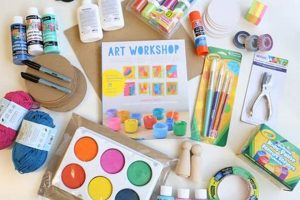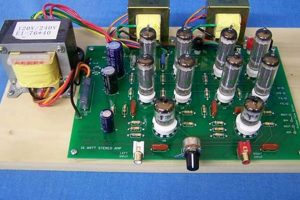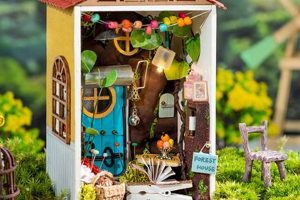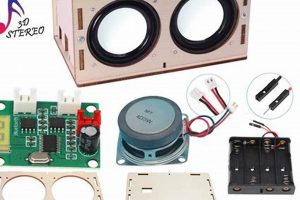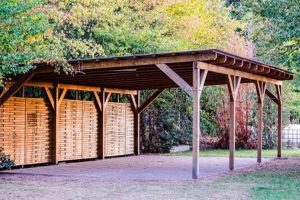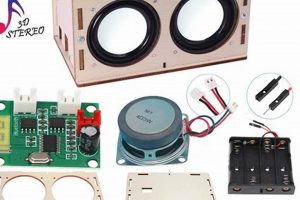These collections provide the components needed to construct miniature enclosed ecosystems. These typically include a glass or plastic container, soil, small plants (such as succulents or ferns), and decorative elements like pebbles or moss. An example includes a package containing a glass jar, activated charcoal, potting mix, a small fern, and decorative stones intended for at-home assembly.
The appeal of such sets lies in their provision of a simplified means of engaging with horticulture, particularly for individuals with limited space or experience. They offer a hands-on learning opportunity in ecological principles and sustainable design. The practice of creating these miniature gardens dates back to the Wardian case, a precursor to the modern terrarium, which gained popularity in the 19th century for transporting plants.
Subsequent discussion will address considerations for selecting appropriate sets, plant choices for optimal growth, and maintenance strategies to ensure the long-term health and aesthetic appeal of these contained environments.
Optimizing the Use of These Assembled Sets
The following advice focuses on achieving successful results when using prefabricated horticultural collections. Attention to detail in assembly and ongoing care is critical to maintaining a thriving contained ecosystem.
Tip 1: Container Selection: Prioritize clarity. Opt for sets using containers with transparent walls to maximize light penetration. Avoid tinted or heavily textured glass, which can impede photosynthesis.
Tip 2: Substrate Composition: Understand the importance of layered media. Ensure the set includes a drainage layer (gravel or pebbles), a separating barrier (mesh or fabric), and a nutrient-rich growing medium. These layers promote water management and prevent root rot.
Tip 3: Plant Compatibility: Select sets with plants suited to the enclosed environment. High humidity and limited air circulation favor moisture-loving species. Succulents, for instance, generally perform poorly in closed terrariums.
Tip 4: Moisture Regulation: Monitor condensation levels. Excessive condensation indicates overwatering; remove the lid periodically to allow excess moisture to evaporate. Conversely, dry substrate suggests insufficient watering.
Tip 5: Light Exposure: Provide adequate, indirect light. Direct sunlight can overheat the enclosed environment, damaging plants. A location near an east-facing window is often optimal.
Tip 6: Pruning and Maintenance: Regularly prune dead or yellowing leaves to prevent fungal growth. Remove any debris or algae buildup to maintain a clean and aesthetically pleasing environment.
Tip 7: Ventilation Considerations: Closed set designs retain moisture effectively, but occasionally require ventilation. Open the container for a few hours weekly to promote air exchange and prevent stagnation.
Careful adherence to these recommendations will maximize the likelihood of cultivating a stable and visually appealing enclosed habitat.
Subsequent sections will address advanced techniques in terrarium design and troubleshooting common issues that may arise during long-term maintenance.
1. Container Material
The choice of enclosure material significantly influences the overall success and longevity of prefabricated horticultural collections. The container dictates the environment within the terrarium, impacting factors from light penetration to humidity levels.
- Transparency and Light Penetration
Glass, due to its high transparency, allows for optimal light transmission, essential for photosynthesis. Plastic, while lighter and less fragile, may degrade over time and can possess lower clarity. The material selected must facilitate sufficient light to reach the plants.
- Material Permeability and Humidity
The container’s permeability affects humidity retention. Impermeable materials, like glass and certain plastics, create a closed system, maintaining higher humidity levels. This is advantageous for moisture-loving plants. However, adequate ventilation strategies must be implemented to mitigate fungal growth.
- Thermal Properties and Temperature Regulation
Different materials exhibit varying thermal properties. Glass, for example, can heat up rapidly in direct sunlight, potentially harming the plants. Plastic may insulate to a greater degree. The material’s thermal behavior must be considered to prevent overheating or extreme temperature fluctuations.
- Durability and Longevity
The chosen material should exhibit resistance to degradation from moisture, temperature fluctuations, and physical stress. Glass, if properly handled, is durable and long-lasting. Certain plastics, however, may become brittle or discolored over time, compromising the aesthetic appeal and functionality of the enclosed environment.
Therefore, the container material is a primary consideration in the selection and utilization of these kits. Careful assessment of transparency, permeability, thermal properties, and durability is essential to creating and maintaining a thriving enclosed garden.
2. Substrate Layers
The composition of substrate layers is critical to the long-term viability of prefabricated horticultural collections. These layers, when correctly assembled, promote drainage, prevent root rot, and provide essential nutrients for plant growth within a controlled environment.
- Drainage Layer Functionality
The base layer, typically comprised of gravel, pebbles, or LECA (lightweight expanded clay aggregate), facilitates water drainage away from the plant roots. This prevents waterlogging, a common cause of root decay. In prefabricated sets, this layer’s absence or inadequacy can lead to ecosystem failure. For example, a kit lacking a sufficient drainage layer risks plant mortality due to oversaturation.
- Separation Barrier Purpose
A geotextile fabric or mesh layer acts as a barrier between the drainage layer and the growing medium. It prevents soil particles from migrating into the drainage layer, maintaining its functionality over time. Its omission will result in the drainage zone becoming clogged, compromising the terrarium’s ability to regulate water levels and potentially causing anaerobic conditions.
- Growing Medium Composition
The growing medium supplies nutrients and physical support for plant roots. Its composition should be tailored to the plants selected for the set, typically a blend of peat moss, perlite, vermiculite, and compost. Incorrect soil mixtures can impede growth. For instance, a set including succulents but containing a water-retentive growing medium would be unsuitable.
- Activated Char
coal IntegrationIncorporating a thin layer of activated charcoal between the growing medium and the separation barrier aids in filtering impurities and reducing odors within the enclosed environment. It adsorbs toxins and prevents the buildup of anaerobic bacteria. Its absence can lead to foul smells and an accumulation of harmful substances that detrimentally affect plant health.
The interplay between these layers dictates the overall health and sustainability of the miniature ecosystem within the assembled set. Proper selection and assembly of the substrate layers are fundamental to realizing the intended benefits of prefabricated collections.
3. Plant Selection
Plant selection represents a critical determinant of success when utilizing prefabricated horticultural collections. The enclosed environment within these kits imposes specific constraints on plant survival and growth, necessitating careful consideration of species compatibility. Ill-suited plant choices are a primary cause of failure in these miniature ecosystems.
The limited air circulation and elevated humidity levels within terrariums favor species adapted to moist environments. Examples of appropriate choices include ferns (e.g., Nephrolepis exaltata), mosses ( Bryophyta), and certain small-leaved tropical plants (e.g., Fittonia verschaffeltii). Conversely, succulents and cacti, adapted to arid conditions, are generally unsuitable due to their susceptibility to root rot in high-humidity conditions. Selection mistakes frequently manifest as plant death, fungal outbreaks, or stunted growth, illustrating the critical impact of informed plant selection.
Therefore, understanding the environmental needs of various plant species and matching them to the conditions within the assembled set is essential for achieving a stable and aesthetically pleasing terrarium. Careful assessment of plant characteristics, including moisture requirements, light needs, and growth habits, is paramount in maximizing the longevity and visual appeal of these contained ecosystems. Kits marketed with species incompatible with terrarium environments present a significant challenge to successful deployment.
4. Water Management
Water management is a critical determinant of long-term stability and plant health within prefabricated horticultural collections. As enclosed ecosystems, terrariums possess unique hydrological characteristics requiring careful monitoring and intervention to prevent detrimental conditions such as overwatering or desiccation.
- Initial Hydration and Equilibrium
The initial watering after assembly establishes a baseline moisture level within the terrarium. This initial hydration must be sufficient to saturate the substrate layers without creating standing water. Insufficient initial watering can lead to plant stress and slow establishment. Conversely, overwatering at this stage can initiate anaerobic conditions conducive to root rot. Achieving a balance is paramount for the long-term success of these kits.
- Condensation Monitoring and Adjustment
Condensation on the interior glass walls provides a visual indicator of the terrarium’s internal moisture level. Excessive condensation signals overwatering, requiring temporary removal of the lid to allow for evaporation. Insufficient condensation indicates a need for additional moisture. The observation of condensation patterns informs watering decisions, contributing to a stable humidity range suitable for the selected plant species. Neglecting this aspect can lead to plant death from either extreme.
- Watering Techniques and Frequency
When watering becomes necessary, the technique is as crucial as the frequency. Direct pouring can disrupt the substrate layers and compact the soil around the roots. Instead, gentle misting or careful application of water along the inner glass wall is preferred. Watering frequency depends on plant species, environmental conditions, and container size, but is generally infrequent due to the closed-system nature of these kits. Regular and excessive watering creates a perpetually saturated environment, predisposing plants to fungal infections and root rot.
- Drainage Layer Assessment and Functionality
The drainage layer, typically comprised of gravel or pebbles, functions to collect excess water and prevent direct root contact with saturated soil. Monitoring the water level within the drainage layer is essential. If the water level rises excessively, it indicates poor drainage, necessitating intervention such as siphoning off the excess water. Failure to maintain a functional drainage layer compromises the entire water management system within the prefabricated horticultural collection.
Effective water management in these assembled sets requires a delicate balance of initial hydration, ongoing monitoring, appropriate watering techniques, and ensuring the functionality of the drainage system. These factors, acting in concert, contribute to a thriving and self-sustaining miniature ecosystem.
5. Light Exposure
Light exposure represents a fundamental factor influencing the success or failure of prefabricated horticultural collections. Given the enclosed nature of these miniature ecosystems, plants are entirely reliant on external light sources for photosynthesis, growth, and overall survival. Managing light exposure is therefore critical.
- Photosynthetic Requirements
Light provides the energy that plants use to convert carbon dioxide and water into sugars, fueling their growth. Different plant species exhibit varying light intensity requirements. Low-light plants, such as ferns and mosses, thrive in shaded conditions, whereas higher-light plants, often unsuitable for closed terrariums, require direct sunlight. Misjudging the plants’ light needs leads to stunted growth, etiolation (elongated stems and pale leaves), or death.
- Light Intensity and Placement
The intensity of light reaching the plants is determined by the orientation and proximity to the light source. Placing a terrarium in direct sunlight can result in overheating and scorching of the foliage. Conversely, inadequate light exposure results in weakened plants susceptible to disease. Indirect, filtered light, such as that from a north- or east-facing window, is generally optimal. The distance from a light source must be considered; plants placed too far from a window may not receive sufficient illumination.
- Light Spectrum and Artificial Illumination
Plants utilize specific wavelengths within the light spectrum for photosynthesis. Natural sunlight provides a full spectrum, but artificial light sources, such as fluorescent or LED grow lights, may be necessary in environments with limited natural light. The spectrum of artificial light must be balanced to provide the wavelengths necessary for healthy plant growth. Lights emitting primarily blue or red wavelengths are often preferred. An unbalanced spectrum can lead to abnormal growth patterns or reduced photosynthetic efficiency.
- Photoperio
d and Diurnal CyclesThe photoperiod, or the duration of light exposure each day, also influences plant growth and development. Most terrarium plants benefit from a consistent diurnal cycle, with a period of light followed by a period of darkness. Extended periods of darkness or continuous illumination disrupt these cycles, potentially leading to stress and reduced vigor. Maintaining a consistent light schedule, either through natural light exposure or artificial illumination, is crucial for long-term plant health.
Optimal light exposure within prefabricated horticultural collections requires careful consideration of photosynthetic requirements, light intensity and placement, light spectrum, and photoperiod. Addressing each factor ensures the plants receive the necessary energy to thrive in their enclosed environment. Consequently, prefabricated kits frequently include guidance pertaining to appropriate lighting conditions.
6. Pruning Regimen
The establishment of a consistent pruning regimen constitutes a pivotal aspect of maintaining prefabricated horticultural collections. Inherent to enclosed environments, the unchecked growth or decay of plant material can rapidly destabilize the delicate ecological balance within. The diminutive scale of these ecosystems necessitates proactive intervention to ensure optimal health and aesthetic appeal. A neglected set, for instance, may experience excessive foliage obstructing light penetration to lower-lying plants, leading to their decline. Regular pruning mitigates this effect by controlling plant size and promoting air circulation, thereby reducing the risk of fungal diseases encouraged by stagnant air.
Specific pruning techniques must be tailored to the plant species within the set. Removal of dead or yellowing leaves prevents the spread of fungal pathogens and redirects resources to healthy growth. Trimming overgrowth ensures plants do not overcrowd the container, allowing adequate space for each specimen to thrive. Consider a collection containing Fittonia. Its tendency to spread horizontally requires periodic trimming to prevent it from dominating the limited space. Similarly, any flowering shoots should be carefully considered. Allowing blooms to develop excessively can tax a plant’s resources, hindering vegetative growth, which is typically more desirable within the confined space of a terrarium. Pruning tools should be sterilized to prevent introducing diseases into the controlled environment.
In summary, a dedicated pruning regimen is not merely an aesthetic consideration but a fundamental requirement for the sustainability of prefabricated horticultural collections. Strategic trimming promotes healthy growth, prevents disease, and maintains the visual balance within the enclosed ecosystem. Addressing the specific needs of individual plant species through careful and regular pruning directly contributes to the longevity and beauty of these self-contained gardens.
7. Ventilation Control
Ventilation control is a crucial, yet often overlooked, aspect of prefabricated horticultural collections. These closed or semi-closed environments require strategic air exchange to prevent the buildup of excessive humidity and the proliferation of harmful microorganisms. The kits often include instructions addressing humidity levels, but rarely sufficiently emphasize the importance of actively managing ventilation. Inadequate ventilation directly contributes to fungal diseases and root rot, common causes of failure in these miniature ecosystems. The direct consequence of insufficient air circulation is the proliferation of anaerobic bacteria, further compromising the health of the plants within. Real-world examples of neglected sets consistently demonstrate a direct correlation between limited ventilation and ecosystem collapse.
Practical application of ventilation control ranges from simple measures like periodically removing the lid to more sophisticated approaches involving the integration of small fans or vents. The frequency and duration of ventilation periods depend on several factors, including the size of the container, the plant species involved, and ambient humidity levels. A hygrometer can be utilized to measure humidity levels within the terrarium, providing quantitative data to guide ventilation adjustments. Some advanced DIY setups incorporate timer-controlled fans to automate ventilation cycles, mimicking natural diurnal variations in air circulation. These adaptive techniques extend the longevity and stability of the contained environment.
Effective ventilation control presents a primary challenge in managing these enclosed ecosystems. While entirely sealed systems offer a certain aesthetic appeal, they often prove unsustainable in the long term without active ventilation. Successfully implementing ventilation strategies allows for a broader selection of plant species to be cultivated, mitigating the risk of disease and fostering a more robust miniature environment. This facet of terrarium management should be recognized as central to the long-term success of these prefabricated horticultural kits, demanding informed understanding and consistent application.
Frequently Asked Questions
This section addresses common inquiries regarding the utilization, maintenance, and potential challenges associated with prefabricated horticultural collections. The following questions and answers aim to provide clarity and practical guidance for achieving successful outcomes.
Question 1: What constitutes a typical “diy terrarium kit”?
The term encompasses a collection of materials designed for constructing a miniature enclosed garden. These materials typically include a transparent container (glass or plastic), substrate components (drainage layer, separation fabric, growing medium), selected plants, and decorative elements (pebbles, moss, figurines). Some sets may include additional items such as activated charcoal or specialized tools.
Question 2: Are all plant species suitable for inclusion in “diy terrarium kits”?
No. The enclosed environment within terrariums presents unique challenges. Plants suited to high humidity and low air circulation are generally preferred. Examples include ferns, mosses, and certain tropical species. Succulents and cacti, which require drier conditions, are typically unsuitable.
Question 3: What is the purpose of the layered substrate system commonly found in “diy terrarium kits”?
The layered substrate system is crucial for drainage and preventing root rot. The bottom layer, typically gravel or pebbles, facilitates water drainage. A separation fabric prevents soil from migrating into the drainage layer. The growing medium provides nutrients and support for plant roots. Activated charcoal, if included, aids in filtering impurities.
Question 4: How often should prefabricated “diy terrarium kits” be watered?
Watering frequency depends on several factors, including plant species, container size, and environmental conditions. Monitoring condensation levels on the container walls serves as an indicator of moisture levels. Excessive condensation suggests overwatering, while a lack of condensation indicates a need for moisture. Watering should generally be infrequent due to the enclosed nature of the system.
Question 5: What type of lighting is optimal for plants within “diy t
errarium kits”?
Indirect, filtered light is generally preferred. Direct sunlight can overheat the enclosed environment, potentially damaging plants. A location near an east-facing window is often suitable. In situations where natural light is limited, artificial lighting, such as fluorescent or LED grow lights, can be utilized.
Question 6: Why is pruning necessary for plants within “diy terrarium kits”?
Pruning is essential for maintaining balance and preventing disease. Removing dead or yellowing leaves prevents the spread of fungal pathogens. Trimming overgrowth ensures adequate light penetration and air circulation. Sterilizing pruning tools minimizes the risk of introducing harmful microorganisms.
In summary, the successful utilization of these prefabricated kits hinges upon an understanding of fundamental ecological principles and consistent application of appropriate maintenance techniques. These techniques should be tailored to the specific components and conditions inherent to each individual set.
The subsequent section will explore troubleshooting common problems encountered during long-term maintenance of miniature enclosed gardens.
Conclusion
This exploration has detailed the multifaceted aspects of prefabricated horticultural collections. A comprehensive understanding of the components, assembly process, maintenance requirements, and potential challenges associated with these kits is paramount for achieving sustained success. Attention to container material, substrate composition, plant selection, water management, light exposure, pruning, and ventilation control dictates the long-term viability of these miniature ecosystems.
Given the information provided, consumers are better equipped to approach “diy terrarium kits” with informed expectations and a commitment to ongoing care. The successful cultivation of these enclosed gardens requires diligence and a willingness to adapt to the specific needs of the selected plant species. The knowledge presented offers a foundation for transforming a collection of components into a thriving, self-contained landscape.


